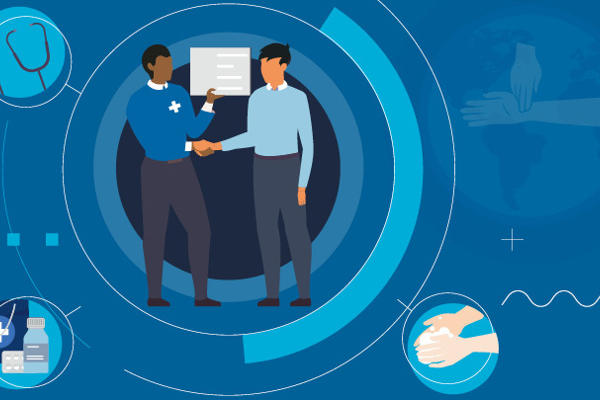The number of COVID-19 cases in our hospitals is definitely declining although it still feels extraordinarily busy (winter is hitting us hard). Safari ward rounds remain common for many of us and the ‘pleasure’ of learning about patients in far-flung places in the hospital on a Friday evening hasn’t lost its ability to fill me with dread.This week has seen a number of interesting developments and publications which I will try and summarise, although I’ve been on call this weekend and up during the night so the usual apology stands if the bulletin feels less refined than usual.
Signal to noise – vaccine safety
I’ll start with vaccine safety. The Medicines and Healthcare products Regulatory Agency (MHRA) is now publishing regular updates on the Yellow Card reports for adverse reactions to the vaccines. As of 24 January there were almost 17,000 reports for the Pfizer/BioNTech vaccine and 6,000 for the AstraZeneca/Oxford one. These reports describe 49,000 possible reactions as each card can be used to report more than one adverse reaction. This looks alarming but the detail provided is reassuring even once it is remembered that this is for over 7.5 million doses. It is worth noting that the MHRA team has done an enormous amount of work looking into the worrying reports. Medicines regulation is all about patient safety and the MHRA folk are showing their value.
Almost all the reports were what would be expected with any immunisation (and what was seen in the trials), including pain at the injection site and flu-like symptoms. There have been 101 anaphylaxis/anaphylactoid reactions described for the Pfizer/BioNTech jab and 13 for the AstraZeneca/Oxford one. This gives a rate of 1–2 per 100,000 doses. We should therefore continue to warn people it may happen.
A number of cases of Bell’s palsy have been reported (69 and 6 respectively for the two vaccines) but this is probably normal incidence for that condition in the age group vaccinated. Previous research looking at Bell’s palsy and flu vaccination showed no association but is helpful as it shows the normal incidence of Bell’s palsy in the UK is 39 cases per 100,000 patient years. Thus, if we estimate that the 7.5 million have been followed up for 4 weeks on average, we would expect 84 cases to occur ‘normally’.
107/34 patients (respectively for the two vaccines) have died shortly after receiving a vaccine dose. Each of these cases has been investigated at length and there is no evidence they are related to the vaccine. Again, death is not that uncommon in the groups of patients we are prioritising for vaccination. Over the age of 85 your chance of dying per day is around 1 in 2,000 (slightly lower for women).
Don’t give up – second doses and variants
Concerns about the timing and availability of second doses persist, although the data published last week around the increased effectiveness of the AstraZeneca/Oxford vaccine when given at 12 weeks is reassuring. The noise about vaccine export from the EU also seems to have calmed down but discussion around trials that mix vaccine types has reignited concerns for those awaiting the second dose that they will get a different vaccine. Some of the statements coming out from government have been a little vague as to the policy for this.
This was raised by college presidents with Prof Chris Whitty last week and he was very clear (and happy to be quoted) that people should receive the same make of vaccine for their second dose and there is no plan to change this. There are data from other immunisation programmes that show mixing vaccines is advantageous but the trials for mixing COVID-19 vaccines are only just starting and for the current round different vaccines should not be substituted between doses.
The news from the AstraZeneca/Oxford vaccine trials in South Africa over the weekend is a little concerning as it shows that it is much less effective for the new SA variant (B.1.351 – which accounts for most cases in S Africa currently). I haven’t seen the full data but the NY Times reported that there were 19/748 cases of the B.1.351 variant in vaccinated people compared with 20/714 in those getting placebo. Small numbers but concerning all the same. This ‘vaccine escape’ isn’t altogether surprising though and confirms what I said last week that we will almost certainly need a booster to protect against variants later in the year.
Red rain – anticoagulation in COVID-19
Fairly early on in the pandemic the impact of COVID-19 on the clotting system became clear with evidence of thrombosis in both large and small vessels as well as in external circuits (such as those used for dialysis) despite prophylactic anticoagulation. COVID-19 results in a hypercoagulable state though systemic and localised factors. As in any acute inflammatory state fibrinogen, factor VIII, D-dimer and VWF levels are all raised. There is also direct viral infection of the endothelium via ACE2 with resulting activation, damage and local vascular inflammation.
Various anticoagulation approaches have been tried but a consistent message and evidence base as to best practice has been absent. To try and get some clarity three research trials (REMAP-CAP, ATTACC and ACTIV-4a) have been collaborating through harmonised protocols and have now published their interim report.
There are four key messages from these results. Firstly, therapeutic dose heparin worsens outcomes, compared to standard of care, if initiated when patients are severely ill with COVID-19 (ie in ICU receiving organ support). Secondly, for moderately ill patients therapeutic dose heparin is beneficial and results in fewer days of organ support and a lower mortality. Thirdly, D-dimer results are not useful to guide anticoagulation dosing strategies. Lastly, in both moderate and severe COVID-19 patient cohorts, overall risk of major bleeding was low compared with previous large observational studies of hospitalised non-COVID-19 patients receiving conventional thromboprophylaxis or therapeutic anticoagulation.
We’ve published a useful explainer on this from Charlotte Bradbury and Cheng-Hock Toh on our website as part of our research hub. We should remember that these are interim results and (as often these days) not peer-reviewed. The optimal dosing requirements and the role of antiplatelets are still being defined in studies and it looks like the timing of anticoagulation is critical. However, these rather unheralded results suggest to me that we will be seeing much more therapeutic anticoagulation for COVID-19 patients not on ITU.
The drop – understanding how COVID-19 is spread
As I said last week, we are still not entirely certain of the main routes of COVID-19 transmission, although the aerosol route seems critical. Four papers this week increase our understanding, although they raise as many questions as they answer.
In the early days of the pandemic we were not sure about the role of asymptomatic spread and based on the experience with SARS, initial responses were guided by the (false) assumption that asymptomatic spread was unlikely. We now have data from over 19 million international travellers entering China between April and October last year to understand this. The size of the study population is testimony to the ability of China to carry out PCR testing on large numbers of people and is in itself quite mind-boggling.
From those 19.4 million travellers (mostly male and between 20–49 years of age) there were 3,103 positive tests of which 43.6% had symptoms at entry, 4.4% developed symptoms and 51.9% never developed symptoms. I am slightly surprised that the number of positives was so low, but this is good evidence that for every symptomatic person next to us there is an asymptomatic one. Trust no one.
Two papers from Michael Marks (who deserves congratulations both for the work and for getting a consultant post recently) show that community spread within certain populations can be very high and that viral load is possibly more important than symptoms. The first study showed that the seroprevalence for SARS-CoV-2 was 64% in a large population of strictly Orthodox Jewish families. This is one of the highest seroprevalence rates that has been recorded for any community and shows that we must tailor our thoughts about how to manage COVID-19 at the local community level as much as the national one.
The other study, based in Spain, followed up contacts from 314 cases to look at onwards transmission. The ‘secondary attack rate’ was 17% but varied from 12% to 24% depending on the viral load of the index patient. Half of contacts who became positive remained asymptomatic (confirming the China data above) and the attack rate was highest for household contacts (not surprising). One interesting finding was that there was no association between coughing and risk of transmission and that it was viral load not symptoms that was the main driver to ongoing transmission. Viral load also predicted whether a contact would become symptomatic.
The last study looked at the aerosol production in healthy volunteers on air, high-flow nasal oxygen (HFNO) or CPAP. The current wisdom is that HFNO and CPAP generate a large aerosol and thus create a high risk but this study challenges that. It showed that CPAP produced negligible aerosol and that HFNO aerosol was almost all from the machine rather than the patient. Coughing was by far the largest source of aerosols (although wearing face masks reduced this substantially).
Putting all of this together means that we should not drop our guard at any point soon and, sadly, it is close contact with people that carries the greatest risk. The debate about the risks associated with coughing is unresolved and urgently needs clarification. Coughing patients should be strongly encouraged to wear masks.
In your eyes – ivermectin
I’ve had a few emails this week about ivermectin and asking why I was not acting as a strong proponent for its use as an anti-viral. I can’t worm my way out of this debate it seems. Ivermectin is a widely used antiparasitic especially in countries where such diseases are common. In the UK and US it is used most commonly for scabies, although it is used much more frequently in pets (which makes it fairly accessible to the public). There is some rationale for its use in COVID-19 patients as it is known to inhibit viral replication in cell lines.
In South America the vogue for using ivermectin has gathered momentum and some trials are promising with regard to impact on viral load and some symptoms. However, the evidence for an effect on hospitalisation rates and mortality is currently lacking as described well in a systematic review from Peru of studies including over 7,000 patients. I therefore think we should keep an open mind as to the place of this drug but I agree with the US National Institutes of Health’s statement that the evidence base is too poor to recommend its use currently. I note that Merck, the manufacturer of ivermectin, has also distanced itself this weekend from its use in COVID-19.
Even in the era of vaccinations it is likely that we will struggle to control the virus on a wider scale and will need antivirals as a further part of our treatment options. Big pharma certainly has this view and is investing hugely in this area. However, Tamiflu taught us that we should ensure we have good evidence for a drug before recommending widescale use.
More than this – IMT issues
IMT stands for internal medicine training and has replaced core medical training and higher specialty training in general (internal) medicine (which itself replaced general professional training). I continue to work with my fellow presidents in Scotland on the issue of standalone IMT year 3 placements, alternative certification and future specialty training posts. If those phrases don’t mean anything to you, I can assure you that for trainees who are affected the current time is one of considerable angst. It feels like we are making some headway but there is a long way to go.
There are a few new resources on the JRCPTB website that may help explain the landscape, allay some concerns as to the impact of COVID-19 and allow new ways of training to be recorded. The former include a guide to transition to the new curricula, recruitment during the period of introduction to these curricula and a guide to all the organisations involved.
The outpatient care assessment tool (OPCAT – you can always rely on the education system to produce a new acronym) is a way to record outpatient activity be it face-to-face or virtual. It isn’t mandatory but should be helpful to anyone trying to show evidence of outpatient experience.
This is the picture – MTI
MTI is not IMT mistyped but the Medical Training Initiative which is a UK-wide scheme for international medical graduates to enter UK training posts for a 2-year period. The scheme is mutually beneficial and allows these international doctors to develop their skills over 2 years, support the NHS while they are here, and on return to their home country benefit the local community with their increased clinical knowledge and skills.
The RCP MTI team has recently published a list of the doctors who have been interviewed as part of ‘Route B’ of the scheme, and are available to be placed in UK trusts in a variety of specialties and grades. The MTI scheme has been very successful in those hospitals which have embraced it and I encourage everyone to think if it might be something that they could both help with and be helped by. You can view the full list on our website (this will be regularly updated throughout the year).
Sledgehammer – the new NHS white paper
Last Friday the impending White Paper on new legislation for health and social care was leaked. I haven’t had a chance to read it in full yet but if you want a good summary (and a slightly cynical view) Andy Cowper’s editorial on the Health Policy Insight website does this well. He has had a bit longer to read it and understands NHS policy better than most.
I will cover this in more depth next week but the headlines are that this signals a formal end to ‘the Lansley Act’, gives the secretary of state for health and social care (SoS) more power, enshrines integrated care systems (ICSs) in law and reduces the powers of foundation trusts. It gives the SoS more say in the planning of workforce which may be a good thing or a bad thing.
The timescale for most legislation like this is that it takes about a year before it becomes law. There will be much debate in that time but judging from comments so far Mr Hancock’s bill will be better received than its predecessor.
Growing up – modern ward rounds
Having spent the weekend wandering around various wards I was struck by how ward rounds have changed since I started as a physician – in some ways quite a lot (electronic patient records, automated observations, many more tests available to consider and PPE) and in other ways not much (missing patients, overstretched staff, the importance of good communication between medical and nursing staff to mention just three).
We have just released new guidance on ward rounds together with the RCN, RPS, Chartered Society of Physiotherapy and NHS England/Improvement which is centred on improving the last of these ‘not much’ changes. The guidance focuses on a standardised multidisciplinary approach to inpatient care which involves patients, carers and families. It aims to be as practical as possible with templates, checklists and advice.
Big time – COVID-19: 1 year on seminar
A year ago the pandemic was changing from something happening elsewhere to something that seemed likely to impact all of us. We held an evening ‘teach-in’ at the RCP attended by over 400 people to hear Chris Whitty, Susan Hopkins, John Edmunds and others update us on what might be in store. Gosh, how much has happened in that year?
We thought we should try and get some of the band back together for another gig and COVID-19: 1 year on is planned for next Thursday evening (18 February) to allow everyone to review the year and assess what the future holds for us. The audience will be virtual this time but the issues will be all too live.
That voice again – fellowship offers
When I became registrar the fellowship process was a once-a-year affair which dominated my Christmas holidays. Now it is spread out over the year and the next group of fellows approved at Council in November were notified electronically yesterday. Congratulations to all 138 of them. These individuals have all shown themselves to have gone above and beyond in their roles and are a credit to medicine. I am looking forward to meeting many of them in the coming years.
… and finally
I heard an inspiring story last week about a fourth-year medical student (called Theo and who probably won’t read this) who volunteered to help on his local ICU. He wrote about his experiences in a blog which was picked up by the CEO and forwarded to me. After describing his experiences and saying that the camaraderie he felt would stay with him always, he concluded:
‘I will carry this experience with me into my future clinical career. When I feel outside of my comfort zone whether that be on my first day as a foundation doctor or maybe one day as a consultant, I will think back to a cold, wintery day in January 2021, when I suited up in full PPE and entered into a room full of a virus which I had spent the last 8 months doing everything possible to avoid, driven by a deep desire to do my part. It is an honour to know I have been able to help in some way.’
We all go outside our comfort zone sometimes. It is often uncomfortable, scary even, but there is always something to learn, something to gain and something to give. All of us can make a difference.
Stay safe.




